Henry Purcell’s Dido & Aeneas is my favourite opera. Normally clocking in at just under an hour, it’s a perfect jewel of operatic theatre. When I bought my ticket for the 28 October performance of Dido & Aeneas by Opera Atelier (OA), I assumed that it would be the same production I had seen in Seoul some years before when OA was on tour in East Asia.
It was only a few days before Dido and Aeneas‘ run started that I found out that a half hour of new material had been added, thus bringing the total time with an intermission to 90 minutes.
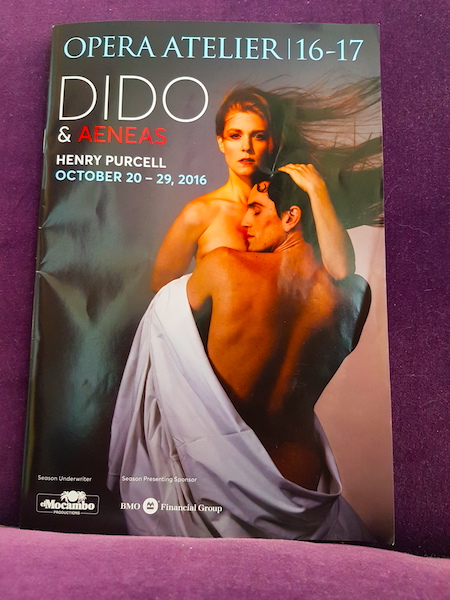
The program for Dido & Aeneas.
So what’s been added? A spoken prologue, a stormy shipwreck scene set to music borrowed from Purcell’s French contemporary Marin Marais, also part of the prologue, and extra dances in the opera proper.
The spoken prologue is historically accurate in that the original libretto does indeed contain a prologue, but no music for it has survived. OA is in fact not the first company to add a spoken prologue. William Christie also added one spoken by English actress Fiona Shaw to Les Art Florissants’ production of Dido & Aeneas for the Opera Comique broadcast on France’s ARTE channel several years ago.
The OA prologue uses words taken from the source material, the early books of Virgil’s Aeneid, to explain the back story of Aeneas’ flight from Troy, arrival in Carthage — this is the part that features the storm music borrowed from Marin Marais — and meeting with Dido. The spoken words were ably declaimed by actress Irene Poole. Much of the story of the prologue was also danced. As one would expect from OA, it was danced to a very high standard that lived up to Marais’ stirring music.
My verdict on the prologue is that while it was well done, it was unnecessary. I didn’t feel that it added anything useful to the dramatic impact of the opera proper, which needs no padding.
I was, however, glad of the extra dance numbers added to the opera. According to the program notes, two chaconnes and a minuet were inserted as per the composer’s original instructions. OA is applauded for its fine renderings of Baroque dance, and rightly so. I was happy to see more dancing seamlessly interwoven with the main action.
In other matters, all the cast were more than up to the job. I will only single out the star of the evening, Ottawa mezzo Wallis Giunta. I had never seen or heard her before, and I fell in love instantly. Her voice is like molten silver, as others have observed, and darkens gorgeously at the low end of her range, which is not always the case with mezzos, and she acts convincingly. She is also a graceful if careful dancer — OA famously makes all its artists step lively — and an elegant clothes horse. Her rendition of Dido’s famous lament was piercingly poignant and undoubtedly the highlight of the night.
Interestingly, the lament was delivered at the very edge of stage centre, with a spotlight on Giunta, and everything and everyone else blacked out. Though unusual, I thought it was an effective device that dialled up the intimacy of the moment.
I should also mention Gerard Gauci’s set design and the costumes. Both were comparatively simple, but elegant and evocative. I couldn’t, of course, take photographs during the performance, but here’s a picture that I snapped of the stage before the show started. Note the chorus, actually the Toronto Children’s Chorus, who acquitted themselves admirably, in the boxes at right.
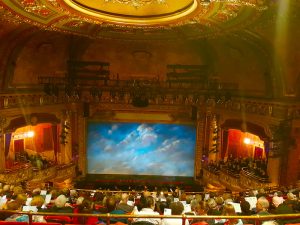
The Elgin Theatre in Toronto, home of Opera Atelier and venue for Dido & Aeneas.
An unlamented absence from the previous OA Dido & Aeneas production: the elaborate coiffures. Wallis Giunta’s own red-gold tresses, for instance, were left to their own devices, which allowed them to drape dramatically and picturesquely over the side of Dido’s deathbed.
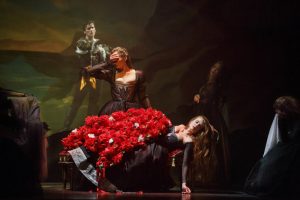
Wallis Giunta’s Dido on her deathbed. Photo credit: Musical Toronto.
On the whole, I was pleased with almost everything. We at Versailles Century prize the Baroque opera above all others, and Opera Atelier is unquestionably its standard bearer in Canada, indeed in North America. I look forward to next spring’s Medea (Charpentier) — which is also going to Versailles in honour of Canada’s 150th birthday. I think I’ll settle for seeing it at the Elgin in April.
Have you seen this or previous productions of Dido & Aeneas? Leave your thoughts below, on the Versailles Century Facebook page, or on Instagram. I’d love to hear from you.







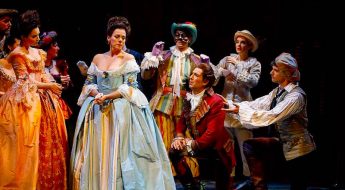
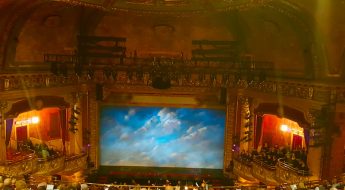
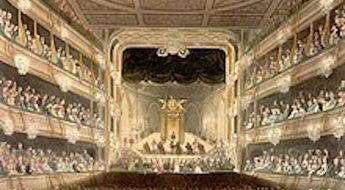








Leave a Comment